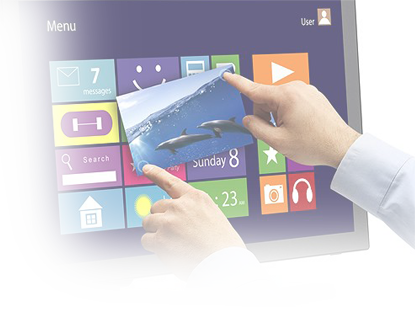

How to Choose a Touchscreen Monitor
Touchscreen monitors let you control your PC without a keyboard and mouse. They are ideal as promotional kiosks, POS monitors, self-service systems, or even for the home or office.

Frequently asked questions when choosing a touchscreen
Capacitive or resistive touch technology?
Capacitive touch technology offers truer colours and greater durability and reacts when you touch the screen even lightly. Multi-touch is often supported, where the monitor detects and processes multiple touches at once. They cannot be operated with gloves or with wet hands. In contrast, monitors with resistive touch technology can be easily controlled even with gloved or wet hands. Compared with capacitive displays, they are usually cheaper. They provide lower-quality colour reproduction, are less durable, and do not support multi-touch.
How to choose the aspect ratio?
For home and office use, we recommend monitors with an aspect ratio of 16:9. This aspect ratio is equally suitable for advertising kiosks, POS monitors, or self-service systems, but all the other options (5:4, 4:3, etc.) can also be considered.
What panel type should I choose?
The panel type has a large impact on the overall properties of the monitor. IPS and S-IPS panels provide the most realistic colour reproduction and widest viewing angles (up to 178° horizontally and vertically). Compared to TN panel monitors, however, they are more expensive and their response times are generally worse. Monitors with PVA and MVA panels are somewhere in between when it comes to image quality and price. They have better colour reproduction and are cheaper compared to IPS and S-IPS display.
Glossy, matte, or anti-glare coating?
Glossy screens provide the most vivid and realistic colours. The downside is that they reflect light from all around them, which means their readability becomes really poor under sunlight. In contrast, matte screens reflect almost no ambient light. Their colour reproduction is not as good and does not seem as realistic. Anti-glare coating achieves a certain compromise between glossy and matte surfaces. Anti-glare screens remain readable under sunlight and their colours are more vivid compared to matte displays.
What connectors should a touchscreen monitor have?
To connect a monitor, you need to have at least one matching video connector on your PC. If not, the two devices will be incompatible.
The basic visual connector is analogue D-SUB (VGA) can be found in older computers (or older graphics cards). Compared to other connectors, it provides inferior image quality. New computers or graphics cards generally feature digital DVI or HDMI ports, which provide a more stable image and better and more vibrant colours. The more expensive models are also being increasingly equipped with DisplayPort which can transmit uncompressed images in very high quality.

Important Parameters


Aspect Ratio
Most common touchscreen aspect ratios:
4:3 and 5:3 - suitable for cashier register monitors.
16:9 - modern standard, suitable for gaming, watching movies, web browsing, office work, as well as for advertising kiosks, POS monitors, or self-service systems.

Brightness
Indicates the monitor luminance when displaying whites. It is listed in cd/m2, and the higher the number, the brighter you can make the image on the screen. Monitors with higher brightness have better readability under strong lighting or direct sunlight. A monitor with a brightness up to 225 cd/m2, is suitable for darker rooms; for well-lit rooms we recommend a model with higher brightness.

Viewing Angles
The viewing angle is the maximum angle from which you can view images on the display without experiencing colour or contrast distortion. Larger viewing angles are obviously better. Viewing angles depend on the type of the monitor. Monitors with IPS and S-IPS panels have the best viewing angles (up to 178 degrees), while PVA and MVA displays are doing slightly worse. The smallest viewing angles are found in TN monitors.
Glossary - Monitors
Display Size
Denotes the distance between the opposite upper and lower corners of the monitor. Listed in inches.
Maximum Resolution
The number of pixels in each dimension that can be displayed on a monitor. Generally, the higher the maximum resolution, the more detailed the picture and the more work or gaming space it provides. Considering modern multimedia standards, your monitor should be at least Full HD (1920 × 1080).
Glossary

Touch Technology
The key parameter in touchscreen monitors. Monitors with capacitive touch technology feature realistic colours and are more durable. They respond well to gentle touches and usually have multi-touch support (the monitor can register multiple touches simultaneously). The downside is that they cannot be operated with gloves and are generally harder to control if the user has wet hands. Resistive touchscreens, on the other hand, can be operated with wet hands or while wearing gloves. They are cheaper, but their colour reproduction is not as good and they do not support multi-touch. They are also less durable.